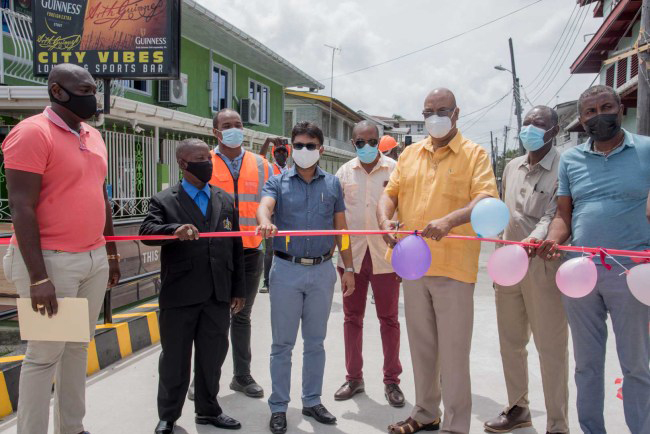A rebuilt bridge at Charlestown, which was broken last September after a container truck reversed onto it, was yesterday reopened for public use.
Speaking at the brief commissioning ceremony, Minister of Public Works Juan Edghill commended Devcon Construction Inc for the timely completion of the bridge at Hogg and Sussex Streets, Charlestown. He said that the project, which was allocated $15,908,051, was completed four weeks ahead of the expected date of completion. This translates to four added weeks that the people of the community would have access to the bridge. The rebuilding of the bridge commenced on December 28th, 2020 and was completed 31 days later on January 28th, 2021.
The Mayor of Georgetown, Ubraj Narine, and members of the city council were also in attendance at the ceremony. The mayor thanked the ministry for its collaborative effort in getting the bridge rebuilt and noted that the ministry responded to a letter from the council requesting its assistance. In response, Edghill said that it was the ministry’s pleasure to come to the aid of the council and have the bridge fixed. Noting that the bridge was damaged on September 11th, 2020, by a containerised hauler which was carrying tons of cargo when it reversed onto this bridge to turn around and subsequently broke it, the minister sought to use the ceremony as an opportunity to educate the nation on ways to assist with the development of the country and to avoid such incidents from recurring.
He said that it is not uncommon for commercial vehicles to travel through communities with weight that the roads are not built to handle. For this reason, he called on the citizens to take better care of the infrastructure. “Development does not mean just repairing what is broken. Development must mean doing new things. And in order for us to do new things we got to care and maintain what is already there. We cannot have a disposable, use and throw mentality as we develop Guyana,” the minister admonished. He added, “We have to have an environment where we maintain and care things,” and in order to do so, he said persons have to understand how things work. He explained that overloading cargo vehicles results in damage to the roadways and urged operators to desist from overloading.
He also mentioned that bridges are being damaged by overweight containers and persons removing the barricade from the footpath of the bridges. In addition, there are also cases where roads are damaged because the vehicles are too wide for the road and end up driving along the road shoulders. Edghill said that persons do not realise that the shoulders are there to stabilise the road and provide adequate drainage. This is often blocked because persons are dumping detritus on the road shoulder when they clean trenches and gutters.
The minister added that when persons do these things and cause damage to the roads and bridges, it is as if they are taking millions of dollars and burning it because fixing the damage costs money. This impedes development since one ends up going around in a circle fixing what is broken, then breaking what is fixed. It is also unfair, he said, as some people may have waited for years to get their infrastructure for the first time.
Edghill called on the Mayor and City Council and the Neighborhood Democratic Councils to help educate the nation about the way to protect against such damage. He noted that this practice that led to the bridge being broken is not practical. “In the developed industrialised countries, container haulers cannot go on certain local streets. You have to go up to a point and then you have to unload onto the smaller business areas [so] why do we want to do it here? It is not practical,” Edghill lamented.



